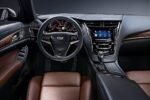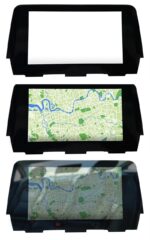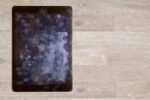Enhanced Visibility and Performance: Anti-Glare, Anti-Reflective, and Anti-Fingerprint Coatings
August 4, 2025
In today's technology-driven world, displays and control panels are everywhere – automotive dashboards, medical equipment, entertainment devices, appliance displays and much more. As screens continue to grow larger and more prevalent, manufacturers face increasing challenges in ensuring visibility and usability across diverse lighting conditions and environments. At Sanwa, we're at the forefront of addressing these challenges through advanced in-mold labeling solutions enhanced with anti-glare, anti-reflective, and anti-fingerprint coatings.

The Growing Need for Advanced Surface Treatments
Many modern vehicles now feature multiple displays – navigation screens, digital instruments, and entertainment systems – often shared between drivers and passengers. Medical offices rely on operational panels and monitors for critical functions. Security systems depend on clear camera lenses and keypads. Gaming devices demand responsive, visible interfaces.
In all these applications, poor visibility can compromise functionality, safety, and user experience.
Beyond Traditional Solutions
While glass touch panels remain mainstream due to their cost-effectiveness, they come with significant limitations. Glass panels cannot accommodate uneven surfaces or extreme curves, and often create visible seams in complex designs. This is where in-mold labeling combined with premium coatings offers distinct advantages:
Adaptability to complex angles: Handle curves and edges seamlessly.
Design flexibility: Create unique and highly-custom parts.
Enhanced durability: Flexible coatings applied before the forming process maintain integrity through manufacturing.

Anti-Glare: Diffusing Light for Better Readability
Anti-glare (AG) coatings work by strategically roughening a display surface through a precise dip coating process. The film is treated edge-to-edge with a solution that creates a slightly rugged surface texture when it dries. This textured surface scatters and diffuses incoming light rays, replacing harsh mirror-like reflections with gentler, distributed light. The result is dramatically improved screen readability, even under bright lighting conditions.
This technology is particularly valuable in automotive applications where dashboard displays must remain visible during peak daylight hours, and in outdoor security installations where control panels face direct sunlight.
Anti-Reflective: Precision Light Management
Anti-reflective (AR) technology takes a different approach, using coatings to reduce reflections at specific wavelengths and incident angles. These coatings use multiple layers with contrasting refractive indexes that bend light in controlled ways, canceling out unwanted reflections.
The effectiveness of anti-reflective coatings is evident in everyday applications – some eyeglasses now feature AR coatings to improve visibility and reduce eye strain. When applied to in-mold labeled components, these coatings ensure displays remain clearly visible in harsh lighting conditions.
Anti-Fingerprint: Maintaining Clarity and Hygiene
Touch-enabled displays face constant contact with fingers, leading to oil smudges, dirt accumulation, and reduced visibility. Anti-fingerprint (AF) coatings address this challenge by repelling oils and contaminants from the surface. This technology is particularly valuable when combined with anti-glare treatments, which can be more susceptible to showing fingerprint marks.
Beyond improved aesthetics and visibility, AF coatings serve critical hygiene functions. In healthcare environments, public spaces, and high-touch applications, these coatings help reduce the spread of germs and bacteria by repelling grime and fingerprints. This reduces cleaning frequency while maintaining a professional, polished appearance longer.

Bonus: Half-Mirror Technology
Not all applications require reduced reflection – sometimes controlled reflection is the goal. Half-mirror coatings create sophisticated mirror-like surfaces that can serve dual functions, acting as both displays and mirrors depending on lighting conditions and activation states.
The Future of Premium Coatings
As technology continues to advance, the future promises even higher demand for these technologies as industries recognize their value in improving user experience, safety, and product longevity. For manufacturers in the automotive and appliance industries, incorporating these advanced coatings into in-mold labeled components represents an opportunity to differentiate products and add value. The combination of design flexibility, enhanced functionality, and improved user experience makes premium-coated in-mold labeling components an attractive solution for next-generation products.